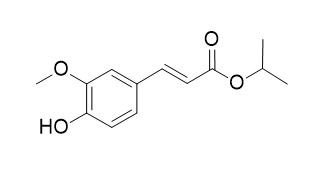Isopropyl ferulate
Reference standards.
Inquire / Order:
manager@chemfaces.com
Technical Inquiries:
service@chemfaces.com
Tel:
+86-27-84237783
Fax:
+86-27-84254680
Address:
1 Building, No. 83, CheCheng Rd., Wuhan Economic and Technological Development Zone, Wuhan, Hubei 430056, PRC
Providing storage is as stated on the product vial and the vial is kept tightly sealed, the product can be stored for up to
24 months(2-8C).
Wherever possible, you should prepare and use solutions on the same day. However, if you need to make up stock solutions in advance, we recommend that you store the solution as aliquots in tightly sealed vials at -20C. Generally, these will be useable for up to two weeks. Before use, and prior to opening the vial we recommend that you allow your product to equilibrate to room temperature for at least 1 hour.
Need more advice on solubility, usage and handling? Please email to: service@chemfaces.com
The packaging of the product may have turned upside down during transportation, resulting in the natural compounds adhering to the neck or cap of the vial. take the vial out of its packaging and gently shake to let the compounds fall to the bottom of the vial. for liquid products, centrifuge at 200-500 RPM to gather the liquid at the bottom of the vial. try to avoid loss or contamination during handling.
Applied Biological Chem. 2020, 26(63).
Tissue Cell.2022, 75:101728.
Front Pharmacol.2022, 13:806869.
Pharmaceuticals (Basel).2024, 18(1):19.
Journal of Ginseng Research2021, 3 June.
Phytomedicine.2022, 96:153877.
Int. J. Mol. Sci.2022, 23(8), 4130.
Korean J. Food Preserv.2023, 30(4):663-668.
Food Funct.2022, 13(14):7638-7649.
Int J Mol Sci.2024, 25(12):6456.
Related and Featured Products
Enzyme Res. 2011;2011:718949.
Synthesis of isopropyl ferulate using silica-immobilized lipase in an organic medium.[Pubmed:
21603272]
Immobilization of lipases has proved to be a useful technique for improving an enzyme's activity in organic solvents.
METHODS AND RESULTS:
In the present study, the performance of a silica-immobilized lipase was evaluated for the synthesis of Isopropyl ferulate in DMSO. The biocatalyst was cross-linked onto the matrix with 1% glutaraldehyde. The effects of various parameters, molar ratio of ferulic acid to isopropyl alcohol (25 mM : 100 mM), concentration of biocatalyst (2.5-20 mg/mL), molecular sieves (25-250 mg/mL), and various salt ions, were studied consecutively as a function of percent esterification. Immobilized lipase at 25 mg/mL showed maximum esterification (~84%) of ferulic acid and isopropanol at a molar ratio of 25 mM : 100 mM, respectively, in DMSO at 45°C in 3 h under shaking (150 rpm).
CONCLUSIONS:
To overcome the inhibitory effect of water (a byproduct) if any, in the reaction mixture, molecular sieves (3 Å × 1.5 mm; 100 mg/mL) were added to the reaction mixture to promote the forward reaction.
Salt ions like Ca(2+), Cd(2+), and Fe(2+) enhanced the activity of immobilized biocatalyst while a few ions like Co(2+), Zn(2+), Mg(2+), Mn(2+), Al(3+), and Na(+) had mild inhibitory effect. Approximately,
one third of total decrease in the esterification efficacy was observed after the 5th repetitive cycle of esterification.



